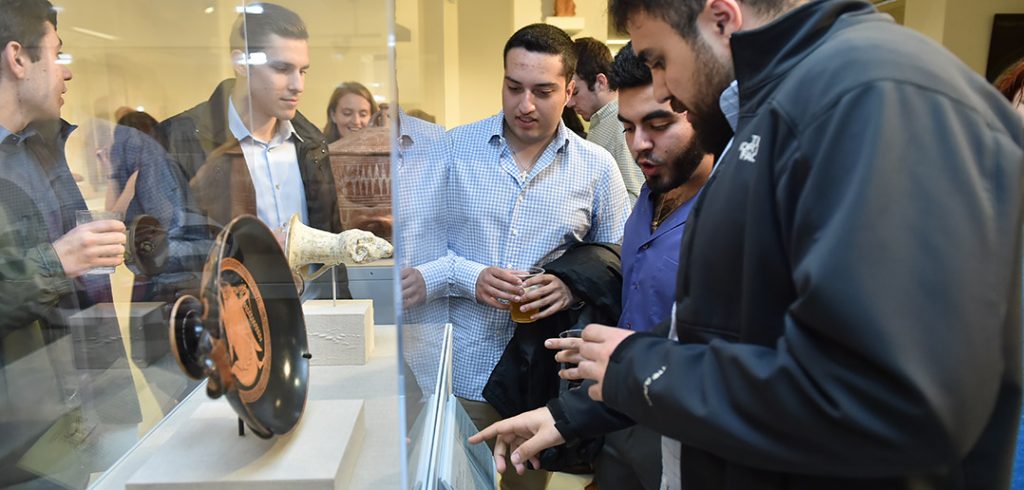As part of a seminar class, students learned firsthand about everything involved in putting on a modern exhibit, including digital technology that helps bring the exhibit to life. And they studied objects that revealed the ingenuity of ancient artisans—like, for instance, the maker of a clay vase that’s so well crafted it appears to be metal.
“I thought that was amazing that 2,500 years after it was created, I’m still fooled by the artist,” said Michael Sheridan, one of 18 students who organized an exhibit at Fordham’s Museum of Greek, Etruscan, and Roman Art.
“The Classical World in 24 Objects,” the first student-curated antiquities exhibition at the museum, is the culmination of a seminar class in museum studies and ancient art. Kicked off with a reception on May 6, the exhibition runs through July 14.
Students curated objects that they picked from the museum’s collection—researching their history, writing the display text to accompany them, and helping to design the display in a newly created gallery at the museum, among other tasks.
“They were involved every step of the way,” said Jennifer Udell, PhD, curator of university art and the seminar’s instructor. She was able to realize her longstanding idea for the project this semester because of a gift from Fordham Trustee Fellow Robert F. Long, GABELLI ’63, and his wife, Katherine G. Long. The gift funded the creation of the special exhibitions gallery, which occupies a recessed area inside the Museum of Greek, Etruscan, and Roman art.
The students picked diverse objects including Roman imperial portraits, luxury household items made of bronze, and quotidian objects like coins and painted pottery. The ornate vase—or kernos—that caught Sheridan’s interest holds a few separate compartments for food, typically offered up to the goddess of the harvest.
“We have some great examples of what life really was like for the ancients” in both the high and low strata of society, said Sheridan, a sophomore double-majoring in history and art history. “So it’s just an interesting insight into a different people group from a different time. Most universities don’t have anything like this, so we really are lucky to have this collection here.”
One of the students, Michael Ceraso, got the idea for making an app to accompany the exhibit because he was taking an app-development class offered for free at Fordham by CodePath University. He teamed up with another student in the app class, Michael Gonzales, to develop the app, which runs on three iPods that are available in the gallery.
In addition to options for searching and sorting among the objects and reading detailed information about them, the app offers audio recordings in which each student explains why he or she chose that object and what makes it interesting.
The library staff was helpful in allowing the app to access the library’s online information about its collection, said Gonzales, a junior majoring in computer science. “It could be a great teaching tool for anyone who’s interested in the museum,” he said.
In addition to putting together the displays, students traveled to other museums and learned about legal and ethical issues—like minimizing looting—surrounding the provenance of artifacts.
The seminar involved a lot of back-and-forth among the students about why their selected pieces were interesting and what the exhibit’s approach should be, said sophomore Masha Bychkova, who plans to go to law school and practice art law.
“It was nice to collaborate with everyone to create an exhibit that encompassed the whole society during these times,” she said.

